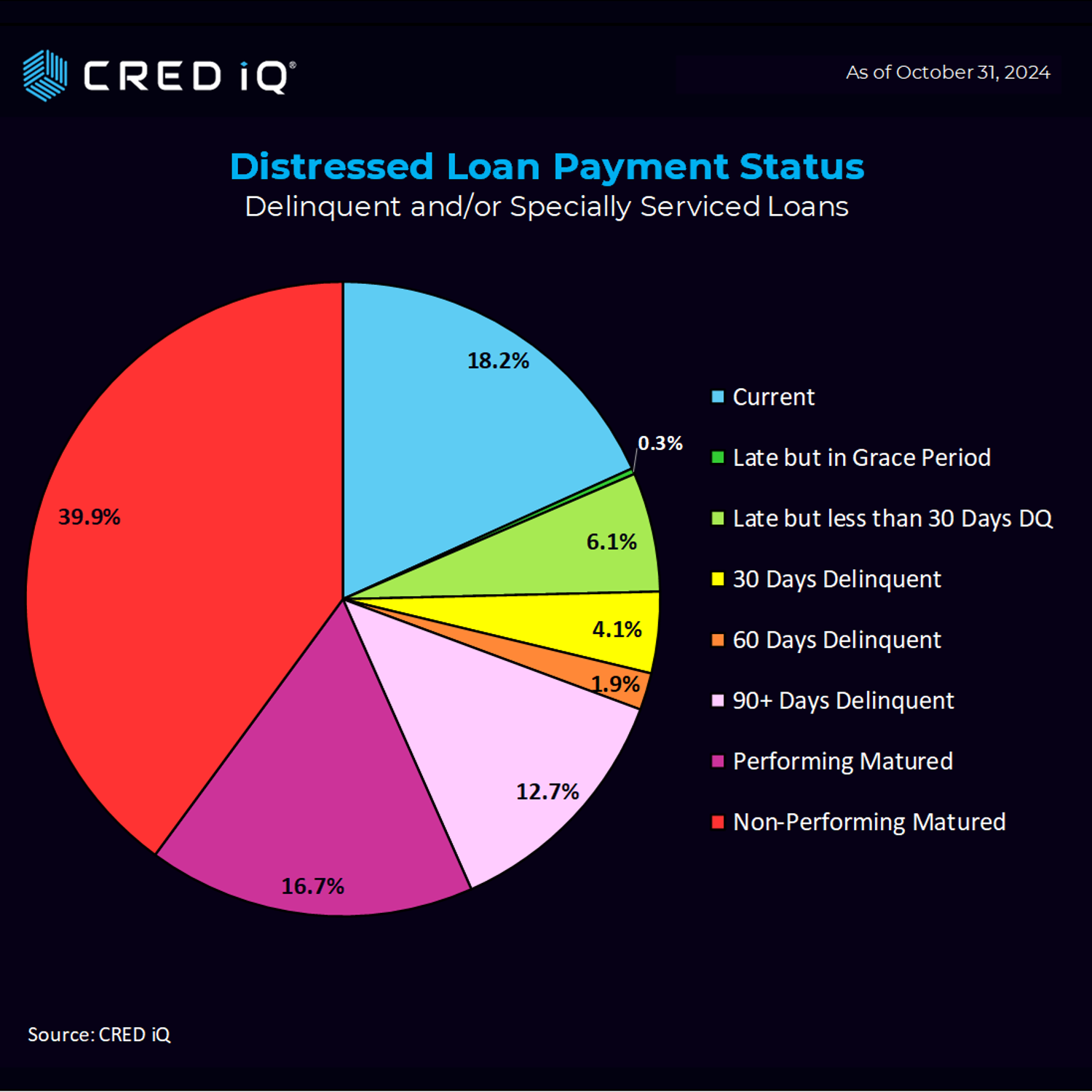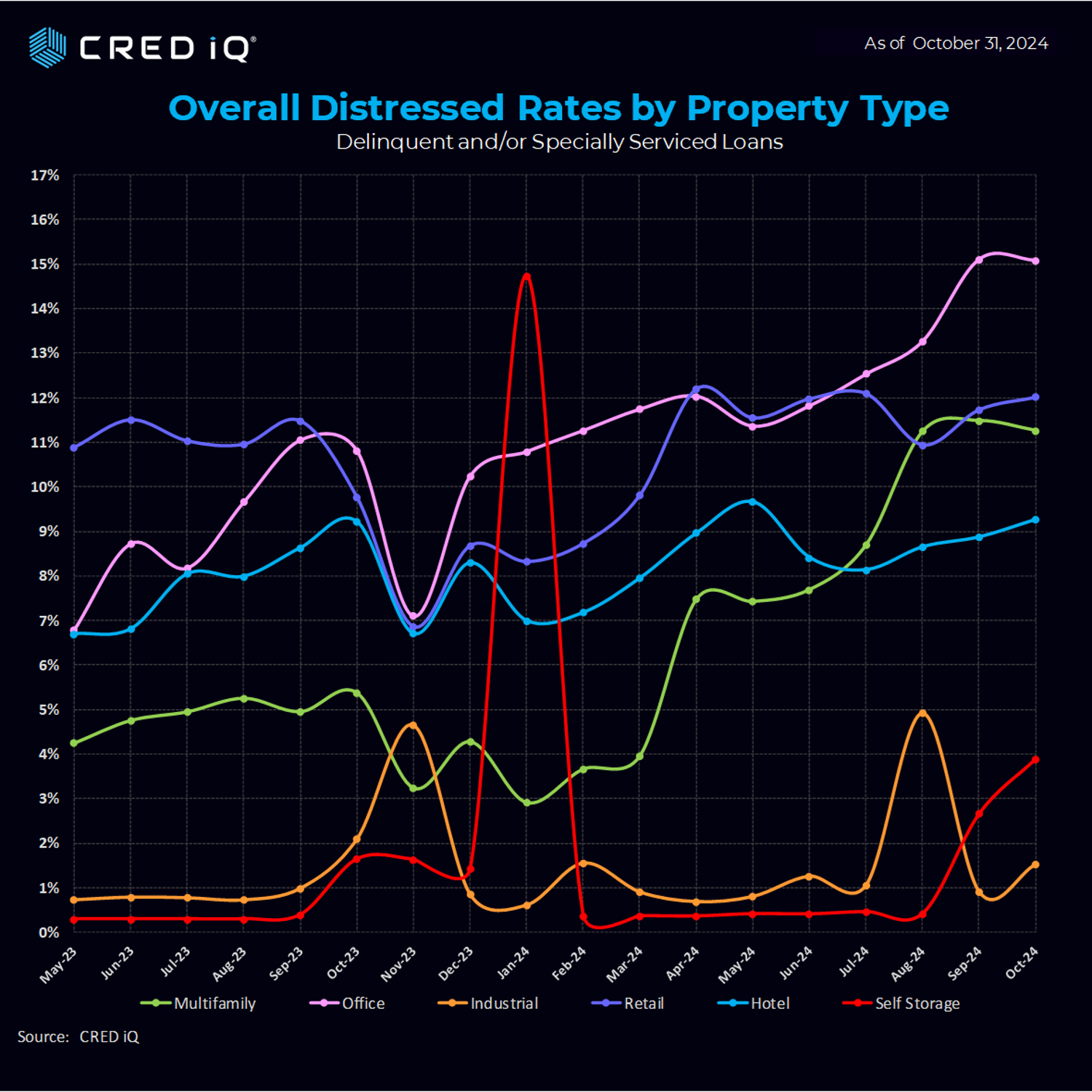The CRED iQ research team evaluated payment statuses reported for each loan (securitized by CMBS financing), along with special servicing status as part of our monthly distress update. Five of the six major property types that CRED iQ tracks climbed higher in October.
The overall CRED iQ distress rate inched up in October by 5 basis points to 9.6% which sets another consecutive record high. CRED iQ’s specially serviced rate added three basis points to 8.7%. Following a flat print last month, our delinquency rate rose from 6.8% to 7.2% during October.
Segment Review
Following a 108-basis point increase in our September print, the office segment distress rate came in flat in this report at 14.8%. As reported last month, the office distress rate has nearly tripled in the last 18 months. Office remains at the top of all segments with respect to distress rate.
Retails remains in the number two slot, with 11.7% distress rate, a slight increase from last month’s print of 11.4%
Right behind retail, multifamily has an 11.0% distress rate—shaving two basis points during October. Multifamily has experienced the sharpest distress increase of all property types in 2024. The January 2024 multifamily distress rate was 2.6%, yielding a stunning 840 basis point increase in the distress rate over the course of the year.
The hotel segment distress rate increased from 8.6% to 9.0% during October, the fourth highest amongst all property types.
The two segments with the highest month-over-month distress rate increases are the same two property types with the lowest distress rates. Self-storage jumped from 2.4% to 3.6% and Industrial added 60 basis points to 1.2%. Two large SBLL loans (CGCMT 2021-PRM2 and BX 2020-VKNG) backed by self-storage and industrial portfolios fell delinquent as they failed to payoff at their October maturity date. Consequently, the CRED iQ detailed loan statuses for both loans fell to performing matured from current in September.

Payment Status
Looking at the distressed loan payment status, 18.2% of the loans are current. Additionally, 0.3% of loans are attributed to late (but in the grace period) and 6.1% of loans were late (but less than 30 days DQ). When we combine these three metrics 24.6% of all loans were current / late within the grace period / less than 30 days delinquent (a reduction of 100 basis points from last month)
Non-Performing Matured decreased from 42.3% to 39.9% (a 240 basis points decrease). Meanwhile, performing Matured increased from 14.5% in our September report to 16.7% (a 220-basis point increase). 90+ Days Delinquent shaved 1 basis points in October to 12.7%.

Analysis Methodology
It’s important to note that CRED iQ’s distress rate factors in all CMBS properties that are securitized in conduits and single-borrower large loan deal types. CRED iQ tracks Freddie Mac, Fannie Mae, Ginnie Mae, and CRE CLO loan metrics in separate analyses.
CRED iQ’s distress rate aggregates the two indicators of distress – delinquency rate and specially serviced rate – yielding the distress rate. The index includes any loan with a payment status of 30+ days delinquent or worse, any loan actively with the special servicer, and includes non-performing and performing loans that have failed to pay off at maturity.

About CRED iQ
CRED iQ is a market data provider that offers a robust suite of data and software solutions tailored for commercial real estate and finance professionals.
With over $2.3 trillion of CRE loans, CRED iQ delivers instant access to a comprehensive range of financial data and analytics for millions of properties in every market. CRED iQ’s data and analytical capabilities are instrumental in helping investors, lenders and brokers make informed and strategic decisions critical to their business.



